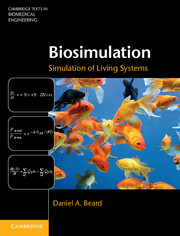Book contents
- Frontmatter
- Contents
- Preface
- Extracts
- 1 Introduction to simulation of biological systems
- 2 Transport and reaction of solutes in biological systems
- 3 Physiologically based pharmacokinetic modeling
- 4 Cardiovascular systems simulation
- 5 Chemical reaction systems: thermodynamics and chemical equilibrium
- 6 Chemical reaction systems: kinetics
- 7 Chemical reaction systems: large-scale systems simulation
- 8 Cellular electrophysiology
- 9 Appendices: mathematical and computational techniques
- References
- Index
3 - Physiologically based pharmacokinetic modeling
Published online by Cambridge University Press: 05 June 2012
- Frontmatter
- Contents
- Preface
- Extracts
- 1 Introduction to simulation of biological systems
- 2 Transport and reaction of solutes in biological systems
- 3 Physiologically based pharmacokinetic modeling
- 4 Cardiovascular systems simulation
- 5 Chemical reaction systems: thermodynamics and chemical equilibrium
- 6 Chemical reaction systems: kinetics
- 7 Chemical reaction systems: large-scale systems simulation
- 8 Cellular electrophysiology
- 9 Appendices: mathematical and computational techniques
- References
- Index
Summary
Overview
Pharmacokinetics is the study of how substances such as drugs and other xenobiotic compounds are transported within living organisms, particularly human beings and animals used as research models. A pharmacokinetic model for a particular drug provides the ability to simulate introduction of the drug into the body (through injection into soft tissue, intravenous administration, absorption from the gut), transport via the circulatory system and delivery to various tissues, excretion (e.g., by the kidney), and perhaps transformation via chemical reactions. Pharmacokinetic models can be useful in predicting and understanding the timescales and concentrations at which drugs appear and disappear from various regions of the body, for setting dosing guidelines for pharmaceuticals and exposure guidelines for toxic compounds, and as a basic research tool for guiding experimental design and analyzing data, as we will see in the examples in this chapter.
Physiologically based pharmacokinetic (PBPK) models are distinguished by their basis in the anatomical and physiological characteristics of the simulated organism. The structure of a PBPK model is derived directly from anatomy and physiology: transport and reactions are simulated in virtual organs that represent the individual organs of the body, and are connected according to the plumbing of the circulatory system; simulated flows mimic physiological flows of blood, gases, and possibly other fluids. Traditional pharmacokinetic models, in contrast, tend to lump flows, organs, and physiological processes together in models that invoke fewer variables and parameters in an effort to minimize the complexity necessary to simulate a given data set or type of data set.
- Type
- Chapter
- Information
- BiosimulationSimulation of Living Systems, pp. 66 - 104Publisher: Cambridge University PressPrint publication year: 2012

